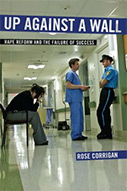Up Against a Wall: Rape Reform and the Failure of Success
 Author: Corrigan, Rose
Author: Corrigan, Rose
Publisher: New York; London: New York University Press, 2013. 320 p.
Reviewer: Patricia Yancey Martin | September 2013
This book, by socio-legal scholar Rose Corrigan, offers an insightful analysis of both lingering and new challenges to reforms in how rape and rape victims are defined and treated. Corrigan alleges that the legal system as a means for producing a social movement is limited because the system co-opts rather than facilitates change. She takes an ironic stance on questions about whether anti-rape reforms have succeeded. The answer depends on how success is defined. For sure, many practices that were accepted formerly are different now due to many positive reforms, e.g., no longer must there be an independent witness, victims are not required to show resistance, physical injury to victim is not required, many states require and/or pay for rape exams, rape crisis centers (RCCs) abound, emergency contraception is often available to victims, and so on. Yet, Corrigan says, the feminist agenda regarding rape reforms was lost and, in essence, the anti-rape movement has been co-opted. In making this case, she regrets many ongoing practices. As the book title suggests, her arguments require readers to consider her thesis carefully. By “failure of success,” she means that serious problems remain despite reforms achieved via feminist mobilization. Today’s problems take new forms and occupy new terrain.
The book has six substantive chapters, preceded by an introduction and followed by reflections on where to go from here. (I overview all six and then say most about Chapters 5, 6 and 7.) The first substantive chapter, Chapter 2, reviews the history of rape-related legislation in the U. S. from the early anti-rape movement days of second wave feminism. This chapter is worth the price of the book. Its review of the history of feminism in relation to the anti-rape movement and rape law/legal reforms is comprehensive and clear. The second substantive chapter, 4, overviews the dynamics of rape victim processing in the community, including how victims and their cases are moved through local systems of medicine/health, the law, and rape care work. Much of this material repeats what we know from other research on these issues. However, the chapter provides a jumping off point for the analyses that follow.
Chapter 5 focuses on Sexual Assault Nurse Examiner (SANE) programs and, to a lesser extent, on Sexual Assault Response Teams (SART). Corrigan assesses the achievements, limitations, and effects of these innovations. Chapter 6 addresses emergency contraception (EC), asking if it is offered to rape victims after the rape kit exam and exploring conditions and “attitudes” that affect whether it is offered, prescribed, or even mentioned. Finally, Chapter 7 overviews the history of Sex Offender Registration and Community Notification laws (SORCN), linking them to the murder of a 7-year old Megan Kanka–thus “Megan’s Law”—and questioning their unintended but negative effects on rape prosecution now. These chapters address the dilemmas rape care advocates and centers face in light of the presumed positive developments that, in everyday life, are not quite so positive.
Research methods for the study are reviewed in Chapter 3. Corrigan collected data primarily from rape care workers (also referred to as rape care advocates). She interviewed 162 workers in 112 rape crisis centers (RCCs; also referred to simply as centers or agencies) in 6 U. S. states: Colorado (32 advocates, 24 centers), Kansas (24 advocates, 15 centers), Michigan (33, 22), New Jersey (14, 14), South Carolina (22, 13), and Washington (42, 24). These states reflect different parts of the U. S. and have diverse histories on rape reform including how victims and crimes are processed. Interviews with workers lasted an hour or more. Corrigan interviewed only women because most centers have no men and she did not study sexual violations of children because they are handled distinctively. She also obtained data from state-wide bodies in the six states that “coordinate and oversee the activities of local RCCs” (p. 26). Some coalitions have considerable influence (e.g., in Michigan) whereas others are basically non-functional (in Colorado). Most work to organize campaigns on rape legislation and some offer training to rape care workers. The rape care workers’ data are more central to the book’s agenda than the coalition data are, however.
Chapter 2 offers an overview of the history of feminism, the anti-rape movement, and the legal system. Corrigan’s thesis is that efforts by feminists to create social change through the legal system backfired. In the end, most RCCs were co-opted, becoming arms of the state rather than alternatives and/or promoters of change. The anti-rape movement lost its radical edge when it cooperated with or gave in to the legal system’s ways of dealing with and defining rape and rapists, she says. The anti-rape movement had no “legal bar” to keep creating new ways of challenging the system. To Corrigan’s regret, anti-rape activists went the route of legislation rather than litigation. As anti-rape activists tried to use the law/legal system to create positive change about rape, they were diverted at every step into doing the work of the state rather than causing the state to change.
Chapter 5 explores issues faced by SANE and SART programs which generally framed as positive innovations that (a) prevent rape victims from being inconvenienced or mistreated in hospital/medical settings; and (b) help local representatives process victims and deal with rape crimes more effectively. Corrigan compares New Jersey where SANE programs are run (and funded) by the attorney general’s office with Michigan where RCCs have the lead in this regard, enabling them to keep law enforcement at bay. Sexual Assault Nurse Examiner programs entail nurses who are trained in post-rape exams to collect evidence from a victim’s body. As a rule, SANE nurses are also trained to support rape victims. Compared to regular emergency room nurses and physicians who resist doing rape exams, SANE programs are viewed as positive developments. Yet Corrigan’s exploration of their formats, practices, and funding statuses in six states reveals their vulnerability to legal system pressures. In New Jersey, where SANE programs are funded by the state attorney general, dependence on that office for funding constrains them from challenging unwanted policies and practices. Community politics constrain all rape assistance programs but funding dependence is particularly constraining. The danger—and frequent result is—that SANE programs function as an arm of the state rather than advocates for victims.
Chapter 6, on Emergency Contraception (EC), offers a sobering review of the barriers to providing rape victims with a “morning after” pill, even when state law requires it. As best Corrigan could determine, 19 U. S. states have a law requiring the rape examiner to offer emergency contraception to victims (13) or to inform victims that such a pill exists (6), e.g., by writing a prescription or noting its availability at pharmacies. [Today, the morning after pill is available without prescription, even to girls under 17.] Merely prescribing or informing may not be effective, however. A trip to a pharmacy may not be feasible, e.g., because the victim lacks transportation and funds. Also, as rape care workers point out, many victims do not seek immediate help. Immediate contraception after a rape experience can be invaluable.
Problems with providing emergency contraception stem from its association with abortion politics. Some legislators, local officials, and nurses and physicians oppose the morning after pill, viewing it as a method of abortion. Corrigan reviews the constraints on implementing the legal requirement. Some Catholic hospitals refuse to provide EC, although most allow victims to be informed and some actually provide it. Most SANE programs insist on providing EC but, even when they do, they walk gingerly in their communities due to the threat of anti-choice forces. Additionally, while the hospital’s policy may state that the victim must be offered EC, sometimes nurses, physicians, and pharmacists refuse (and state law allows them to). “It’s a secret,” one rape care advocate said to Corrigan, “that we offer EC after a rape.” It is ironic that a state law requiring a particular action is mooted if the individuals who should comply with it refuse. This example shows, again, how a legal reform can fail to help rape victims.
Corrigan also addresses the issue of Sex Offender Registration and Community Notification laws (SORCN) relative to rape case prosecution (Chapter 7). The passage of “Megan’s Law” in nearly every U. S. state was done in a flurry of emotion about the urgency of identifying sex offenders in the community. Passage of the law was so popular that opposing it threatened political suicide. Almost no one has qualms about listing middle aged offenders who sexually abuse children on the permanent registry, Corrigan says. But rapists who are 17 or 20 will, if listed, be publicly identified as a sexual offender for 20 or so years, prosecutors and defense attorneys say. Similar to how in earlier times the death penalty was “too harsh a punishment for rape,” the prospect of being listed on the sex offender registry is framed in this way today. Some prosecutors drop rape charges completely because it would be cruel to saddle a young man with this taint early in life. A law aimed at alerting the community about sexually violent persons is being subverted due to concerns about what being listed on the registry can do to a young man’s life, given that all he did was “rape” someone.
This book leaves one with the impression that nothing has worked, that almost everyone working on rape issues has been co-opted. It is true that the red hot heat of early feminist attention to rape has cooled and that many reforms failed to produce the hoped-for results. To be fair, Corrigan does point to examples of progress. However, her focus on what is wrong with what is happening now communicates pessimism. Nevertheless, the book has many redeeming features. Her review of sources is comprehensive and, to my reading, accurate. Corrigan did not miss a single key study on the issues. Furthermore, her narrative is written so that experts and non-experts alike can enjoy and learn from it. Her use of quotes from rape care worker interviews makes fascinating reading. While she interviewed only rape care workers, and not police officials, hospital/medical personnel, or prosecutors directly, her findings resonate with prior research on those professionals and effectively identify their organizational, community, and political vulnerabilities.
The book has a few quirks. RCCs are sometimes referred to as agencies or centers in ways that are not entirely clear. The acronym SANE is sometimes used to refer to a person, although SANE is a program and I never before saw it used for an individual. Without fully explaining, Corrigan claims that laws on domestic violence continued to develop over the past few decades whereas rape law stagnated and that rape reformers unfortunately chose a legislative rather than litigation route to advance their agenda. Fuller development of these claims would have been helpful.
This book is as an invaluable resource for socio-legal scholars, sociologists, criminologists, social workers, women’s studies experts, community ecology psychologists and all who hope to understand rape issues in the U. S. today. Feminist activists and mainstream professionals interested in instituting effective rape law reform are urged to read it. Rape crisis center staff and volunteers as well as police officers, prosecutors, and medical/health care personnel will benefit from Corrigan’s analysis of the organizational, community, and political constraints that affect their work. Finally, the book offers an excellent example of the use of organizational and community informants as “human periscopes” in order to gain purchase on rape work and politics in today’s world. This approach is under-utilized in organizational and community studies and I hope Corrigan’s use of it inspires others to adopt it as well.
Patricia Yancey Martin, Professor of Sociology Emerita, Florida State University, Tallahassee FL 32306-2270, USA. Email: pmartin@fsu.edu


